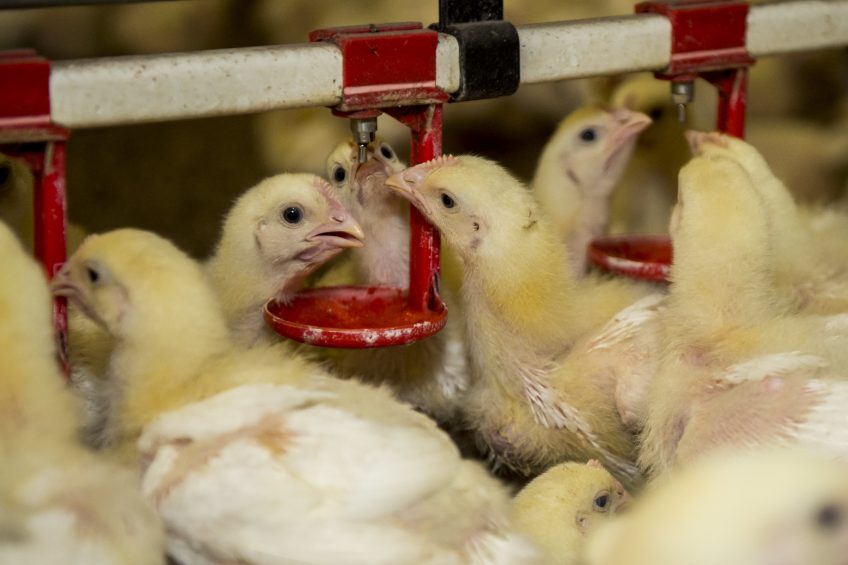Reduce antibiotic usage with drinking water solutions

Drinking water solutions based on alpha-monoglycerides can help to reduce the usage of antibiotic growth promoters (AGPs) and therapeutically used antibiotics. This article explains how the best effects can be reached.
12 years ago the last 4 antibiotics permitted as feed additives to support livestock growth were banned in the European Union (EU). It was the final step to ban the usage of antibiotics for non-medicinal purposes. However, outside the EU antibiotics are still used in feed to boost animal fattening. In these countries the awareness of the actual threat of bacteria resistance, and the demand of importing countries to deliver antibiotic free meat, is increasing. Hence, the interest in alternative feed additives that promote animal health and performance is increasing as well.
Alpha-Monoglycerides
Alpha-monoglycerides possess, like antibiotics, antimicrobial properties. Monoglycerides of short chain fatty acids like propionic acid and butyric acid have bactericidal and bacteriostatic properties against Gram-negative bacteria. Monoglycerides of medium chain fatty acids have antimicrobial effects mainly against Gram-positive bacteria and fat-enveloped viruses. Framelco has developed FRA C12 Liquid (alpha-monolaurin) and FRA LiquiSal Liquid (alpha-monopropionin + alpha-monobutyrin). Both are drinking water solutions to promote animal health and performances.
Antibiotic growth promoters
As mentioned before, AGPs are still used as feed additives in countries outside the EU. The meat production continues to increase on a worldwide scale to feed the human population. The largest growth in meat production is realised by Asian countries from 1960 till now, but also in Southern America the meat production has been massively increased. However, in these regions the use of AGPs is still allowed. To study if alpha-monoglycerides of lauric acid could replace the AGP lincomycin in poultry feed a trial was conducted in Pakistan at the University of Agriculture, Faisalabad.
Seven day-old-broilers were divided over 4 treatment groups (A, B, C and D) with 5 replicates of ten broilers each and the trial started at day 8 (Table 1). Broilers in treatment group A received a commercial diet with lincomycin dosed at 120g per ton of feed. For the other groups (B, C and D) an antibiotic free starter and finisher diet were composed. Group B served as the negative control group as the broilers were fed a diet without antibiotics and additives. Group C and D received next to the antibiotic free diet FRA C12 Liquid via the drinking water. The product was supplemented in group C at a dose level of 1kg/1000L drinking water. Broilers in group D received 2 kg FRA C12 Liquid per 1000L drinking water.
From the trial it can be concluded that adding AGP via the feed or the product via the drinking water improves animal growth and performance compared to the negative control group. FCR was the best in group C and D followed by group A in the starter and finisher period. The highest weight gain in the finisher phase was observed in group D. These broilers had an extra weight gain of 144 grams compared to the negative control group. From this data it is concluded that lincomycin has a good effect on weight gain and FCR. Removing this AGP from the feed will result in a reduction of feed intake, weight gain and FCR. Adding alpha-monoglycerides of lauric acid through the drinking water will increase weight gain and improves FCR even more than lincomycin, suggesting that alpha-monoglycerides are a positive tool to reduce and replace AGP’s in poultry feed.
Antibiotics as a treatment
Next to AGPs in feed, antibiotics are also used to treat an animal when it is ill. It is not only important for animal health to get rid of an infection caused by pathogen bacteria, but also for food safety. Poultry products contaminated with Salmonella are frequently a vehicle for human salmonellosis. In 2014, 65 Dutch children became ill and 7 children were hospitalised after eating a meal contaminated with S. Heidelberg. It is therefore important to reduce the presence of Salmonella in live broilers and to limit faecal shedding as much as possible to lower the risk of meat contamination during slaughter. The antibiotic fosfomycin (FOS) is administrated to broilers for treatment of Salmonella spp. infections. Fosfomycin, a propionic acid derivative, is a broad-spectrum antibiotic. However, the use of antibiotics is not preferred and resistance against FOS and other antibiotics against S. Heidelberg have been reported.
In 2017, a trial was performed by the University of São Paulo and carried out at the Experimental Center of Aviary Pathology of FMVZ-USP (Table 2). The aim of the trial was to investigate the effect of FOS and alpha-monoglycerides of S. Heidelberg infected broilers.
One-day-old male broilers were divided over four treatment groups. The first group was not challenged with S. Heidelberg and did not get any treatment. The other three groups were orally challenged at day 10 with S. heidelberg (SA627) at a dose level of 3.0×106 CFU/0.1ml/broiler. The positive control group was not treated with any antibiotics nor feed additives. The third group received orally 40 mg/kg live weight FOS from day 12 till 18 of life as a treatment against Salmonella. The last treatment group was supplemented with FRA Liquisal Liquid via the drinking water at a dose level of 1.5 kg/1000L from day 8 till day 21. The liver, spleen and caecum were collected to test for re-isolation of Salmonella spp. At day 7 and 21 litter samples were collected to determine the presence of Salmonella spp. in the environment. The organs and litter were found positive or negative for Salmonella spp.
From this trial it could be concluded that the preventive use of FRA LiquiSal Liquid was more effective in reducing Salmonella in broiler organs than a therapeutic treatment of FOS. A reduction of 38% in Salmonella positive livers/spleens was found in the group receiving alpha-monoglycerides compared to the positive control group and FOS group. Feeding alpha-monoglycerides reduced the percentage of positive caecum samples for Salmonella with almost 25% compared to the positive control group. FRA LiquiSal Liquid improved Salmonella depletion with almost 19% compared to FOS in het caecum. In conclusion, alpha-monoglycerides applied via the drinking water have shown to be a tool to help reduce AGPs and therapeutically used antibiotics in poultry.
Join 31,000+ subscribers
Subscribe to our newsletter to stay updated about all the need-to-know content in the poultry sector, three times a week. Beheer
Beheer








 WP Admin
WP Admin  Bewerk bericht
Bewerk bericht